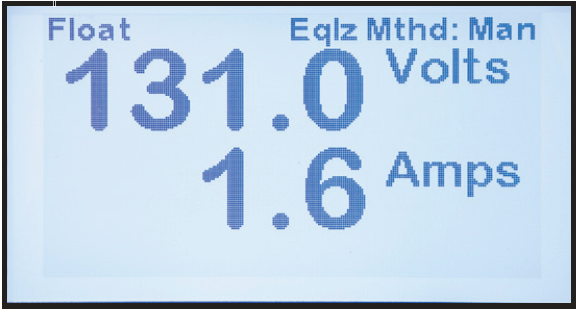The ATevo front panel features a back-lit Liquid Crystal Display (LCD) that is capable of displaying various fonts, text sizes, and graphical objects. The graphical display, in combination with the front panel control buttons, provides an easy-to-use, powerful interface. The various ATevo screens include user prompts and navigation icons to provide an intuitive and hedonic experience.
ATevo screens can be grouped, by function, into four (4) basic types. Click on the expandable toggles below for more details:
- HOME Screen
- The HOME screen is the primary ATevo display, and is active most of the time ATevo is energized. Other screens are displayed during configuration changes, during testing, when the user requests more detailed status than what is provided on the HOME screen, or when the user wishes to utilize one of the advanced ATevo features.
- The Factory Default HOME Screen displays the output voltage (Vdc) and output current (Adc) in a large font for easy reading.
- ‘Float’ or ‘Equalize’ will appear on the left side of the top of the display to indicate that the charger is actively in either FLOAT or EQUALIZE CHARGE MODE.
- ‘Eqlz Mthd: Man’ or ‘Eqlz Mthd: Auto’ will appear on the right side of the top of the display to indicate that the EQUALIZE METHOD is presently configured for MANUAL TIMER or AUTOMATIC TIMER mode.
- If a Temperature Compensation (TempCo) Probe option is installed and enabled, the present battery temperature and normalized voltage set point will also appear on the display (see Section 12 for more details on the TempCo option and display).
- Configuration Screens
- These screens are used for changing ATevo set points and configuration. Many of these screens will be described in Section 6, Startup and Configuration. Other configuration screens for installed options will be described later in their respective installed option sections.
- Status Screens
- ATevo Status screens do not permit any system changes, and are used only for viewing information. Most of the status screens (e.g. Event Log and Active Alarm List) are covered in Section 8, Advanced Operation. The HOME screen can be thought of as a ‘special’ Status Screen in that it can indicate dc output voltage (Vdc), dc output current (Adc), and status of Equalize/Float mode and method.
- Hindle Health System Screens
- Hindle Health System screens are associated with the Hindle Health button (HH). When (HH) is pressed, ATevo enters a user-assisted self-diagnostic mode. Screens prompt the user to participate in a series of tests that confirm that ATevo is operating correctly. For more information on the Hindle Health System, see Section 10.
Last modified:
5 March 2021



